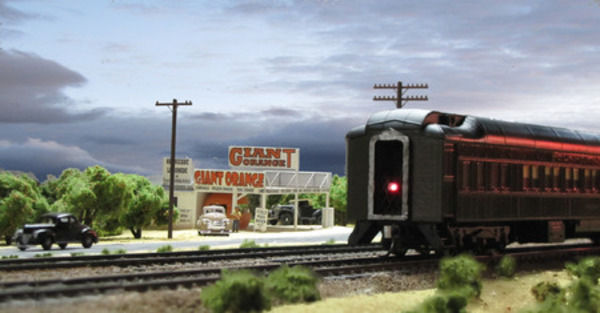

Image above shows one LED and the Plastic Sprue from OMM 10002, (see below for kit contents)
OMM #10002 inclueds parts to build two tailgates with Gyralite markers. This is enough to equip the rear-ends of two single markered passenger car. The kit includes the following parts:

Use these lugs to add reliable power connection to cars with Walthers Passenger Trucks having all-wheel pickup.
Use Link above for more information or PayPal button below to place in your Cart for purchase.
Sorry, we're out-of-stock currently (Dec 2021), please put in a back-order by contacting Jason at Contact Us link
Various types of electric markers came into use during the 1950s as the kerosene lanterns were being converted to electric lights or replaced with other forms of markers (Gyralites and “box lights”). On the Southern Pacific, Union Pacific, and Chicago Northwestern, the push towards electric markers started in 1936 with the City of San Francisco's tailcar having built-in electric markers to denote the rear of the train. The Southern Pacific followed the next year, in 1937, also with built-in electric markers and a large “signal light” built-in the rear car of Pullman's new streamlined “Daylight” between San Francisco and Los Angeles.
_Marker_lights-REV-A.jpg)
Over the years SP's Rulebooks show the adoption of the “electric signal light” combined with the standard lighted markers. The Pyle Gyralite is a combination of the two. It is often seen on the front of SP locomotives with a red lens. Some of these Gyralites still had functional mechanisms to produce the signature “Gyralite Effect” strobing. Union Pacific, Great Northern and several other railroads are known to have also used Pyle Gyralites in passenger marker service.

For modelers, the stobing effect can be simulated with various after-market lighting circuits or lighting-function-only DCC decoders (not included in the OwlMtModels 10002 kit). Modelers wishing to have a brighter flash on the strobe effect should use a resistor between 600-800 Ohms. This will give the desired “Pop” to the light at the brightest setting. The included 1000 Ohm resistor is very satisfactory for the “glow,” visible from 30-50 real feet away, and is not overpowering when viewed at only a few feet away.
Markers were owned by the railroads and were changed out when a train continued onto another railroad's operating control. SP and UP would change crews and markers on passenger trains at Ogden, Utah, for example. SP's Gyralites were known to be painted silver in most cases, but they could have been painted Daylight Red or Armour Yellow for some train assignments (according to a former SP employee). SP's lantern markers assigned to the San Joaquin Daylight were known to be painted Daylight Orange to match the cars of the train. One SP-owned Gyralite at The Original Whistle Stop in Pasadena, CA is painted in UP Armour Yellow. However, we've seen no photos of trains with other than silver Gyralites. SP painted the Gyralites red in engine service after 1958, so it is possible the shops didn't repaint them before assigning to passenger service. UP's Gyralites were painted UP Armor Yellow.